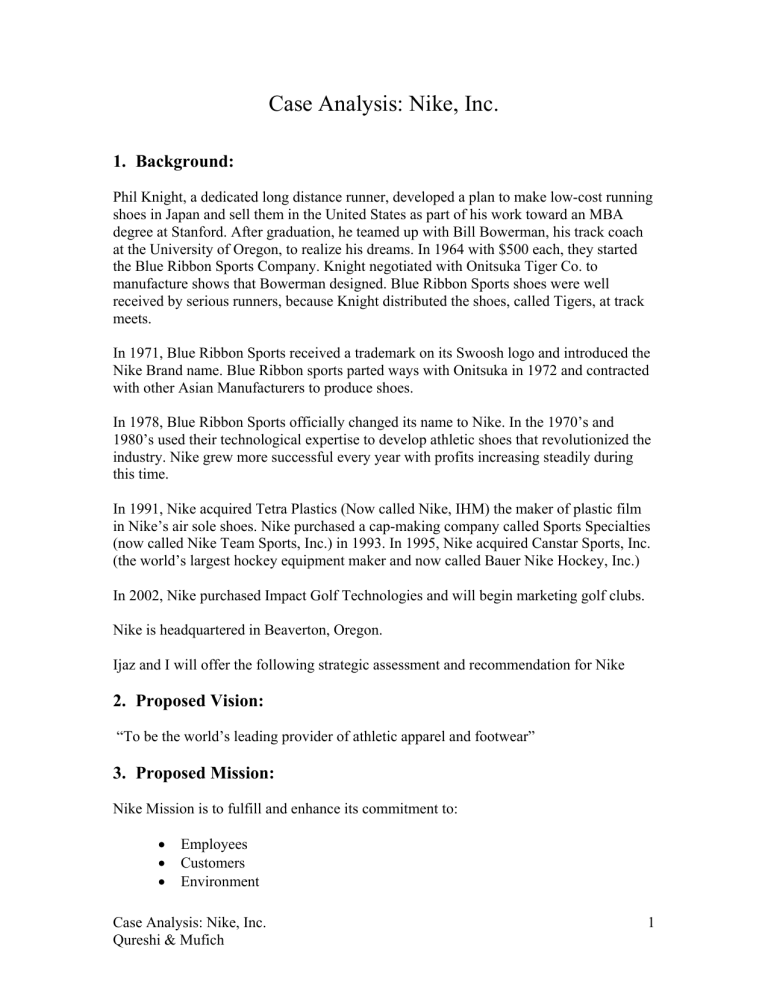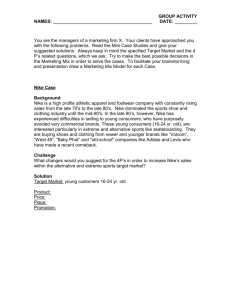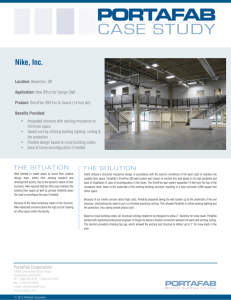Case Analysis

Case Analysis: Nike, Inc.
1.
Background:
Phil Knight, a dedicated long distance runner, developed a plan to make low-cost running shoes in Japan and sell them in the United States as part of his work toward an MBA degree at Stanford. After graduation, he teamed up with Bill Bowerman, his track coach at the University of Oregon, to realize his dreams. In 1964 with $500 each, they started the Blue Ribbon Sports Company. Knight negotiated with Onitsuka Tiger Co. to manufacture shows that Bowerman designed. Blue Ribbon Sports shoes were well received by serious runners, because Knight distributed the shoes, called Tigers, at track meets.
In 1971, Blue Ribbon Sports received a trademark on its Swoosh logo and introduced the
Nike Brand name. Blue Ribbon sports parted ways with Onitsuka in 1972 and contracted with other Asian Manufacturers to produce shoes.
In 1978, Blue Ribbon Sports officially changed its name to Nike. In the 1970’s and
1980’s used their technological expertise to develop athletic shoes that revolutionized the industry. Nike grew more successful every year with profits increasing steadily during this time.
In 1991, Nike acquired Tetra Plastics (Now called Nike, IHM) the maker of plastic film in Nike’s air sole shoes. Nike purchased a cap-making company called Sports Specialties
(now called Nike Team Sports, Inc.) in 1993. In 1995, Nike acquired Canstar Sports, Inc.
(the world’s largest hockey equipment maker and now called Bauer Nike Hockey, Inc.)
In 2002, Nike purchased Impact Golf Technologies and will begin marketing golf clubs.
Nike is headquartered in Beaverton, Oregon.
Ijaz and I will offer the following strategic assessment and recommendation for Nike
2.
Proposed Vision:
“To be the world’s leading provider of athletic apparel and footwear”
3.
Proposed Mission:
Nike Mission is to fulfill and enhance its commitment to:
•
Employees
•
Customers
•
Environment
Case Analysis: Nike, Inc.
Qureshi & Mufich
1
•
Shareholders
•
Social Responsibility
•
Communities
•
Technology
•
New markets
•
Expanded products and services
4.
Issues:
•
The major issue Nike faces is maintaining its competitive edge through innovative methods of Marketing while leveraging its investment in technology. Nike must continue to exploit this advantage by securing athletes from popular and new edge (youth) and extreme sports.
•
Major demographic shifts are taking place in the athletic apparel and shoe industry. With the advent of Atkins and Low Carb Diets, more people are pursuing a healthy life-style with an emphasis on fitness (jogging, biking, swimming, weight training, tennis, golf, etc.) not necessarily demanding the
$150 “Air Jordan” specialty shoe. Additionally, Nike has experienced a problem in Marketing to women as experienced in 1984 when Reebok dominated the women’s aerobic exercise movement. Nike will need to overcome these past blunders while pursuing the youth market (girls and boys) as more females are joining sports activities (especially soccer, basketball, and softball).
•
Nike must also overcome the social stigma associated with: i.
Manufacturing shoes in countries where there are abuses in labor
(especially child labor). ii.
Growing waste in landfills
•
Supply Chain Management appears to be a significant cost to Nike. Nike must look at Lean Supply Chain Management Methods including logistics and transportation costs.
5.
Strengths:
•
The Nike name and logo have such high consumer awareness that the company no longer includes the Nike name on its products. The swoosh logo is all that is needed to recognize Nike.
•
Nike sells a variety of models and styles in footwear and apparel including
Cole Haan and Tensile Air.
•
45% of Total Revenue in 2001 came from international sales
•
Strong Competitive position: Holds a 37% Market Share to Reebok’s 15%
Market share. Currently number 1 in market.
Case Analysis: Nike, Inc.
Qureshi & Mufich
2
•
Contracted Manufacturing to low-wage factories in the Far East allows Nike to focus on marketing, image, and R&D and operate with very little long-term debt.
•
Research & Development focus have designed many innovations such as: i.
Cross-Training Shoes ii.
Nike Footbridge Stability device iii.
Inflatable fit systems iv.
Nike 180 air cushioning system. v.
Nike Swift suit vi.
Nike Shox (16 Years of development)
•
Through international marketing efforts, Nike is number 1 in Spain, France,
Belgium, Holland, Luxembourg, Finland, Italy, and the UK.
•
International Marketing and advertising is developed by local people to fit with local cultures.
•
Social Responsibility: i.
Set up a labor practices department responsibility ii.
Joined the Fair Labor Association iii.
Belong to the Global Alliance for Workforce and Communities. iv.
Developed a Nike Code of Conduct and ensures that factories adhere and follow this code of conduct. v.
NEAT: Nike Environmental Action Team. Pursue environmental initiatives and recycle old athletic shoes and reuse them as new products. Nike recovers 100,000 shoes each month for recycling. It demonstrates it’s concern for the environment by using the recycled materials in the soles of its new shoes and by providing recycled material for sports fields/tracks. Every year Nike recycles 5 million pounds of solid waste.
•
Significant reduction in long term debt.
6.
Weaknesses
•
Nike neglected the $60-$90 shoe market and lost ground in the U.S. footwear market that makes up most of the industry’s U.S. Sales.
•
Use of contract manufacturers makes it difficult to control quality of production.
•
Use of sports stars who fail to perform, behave poorly (use drugs or performance enhancers), retire, or become injured (like Bo Jackson) could adversely effect Nike image and consequently sales.
•
R&D for shoes is created for 5 years in the future. Consumer trends and competition could drastically change in this time and Nike may not be flexible enough to respond to these changes.
•
Contract Manufacturer working conditions in foreign factories could adversely affect Nike image and sales.
•
Use of contract manufacturing in foreign countries has the potential to create financial problems due to foreign currency fluctuations and interest rate changes.
Case Analysis: Nike, Inc.
Qureshi & Mufich
3
•
Contract Manufacturing extends the supply chain from order to delivery.
7.
Opportunities
•
Generation Y Children born between 1979 and 1994 are 60 Million strong and is an important target market for athletic shoe companies. This group is not swayed by glossy advertising but responds to truth in advertising and is more cynical and practical than other generations. They prefer to use the internet as a source of product information.
•
Changes in lifestyles for girls/women will affect the industry. i.
Since the mid-1990’s, women have purchased more athletic shoes than men have. ii.
More girls are involved in sports than ever before: 13 Million women and girls play basketball and 7 Million play soccer.
•
Currently 20% of Nike sales are to women versus 50% industry. Through
Nike Goddess stores and marketing promotion, Nike has to increase sales.
•
Nike must focus a strategy on growing it internet business through www.nike.com
. Nike believes its online business will be an important component of its future sales.
•
Nike can grow in new and emerging markets including Chile, Peru, Bolivia,
India, Mexico, South America, and several eastern European countries.
8.
Threats
•
Use of Contract Manufacturing to countries such as Korea is changing as these countries move to more sophisticated electronic products and do not have the capacity to produce athletic shoes.
•
Overseas production could be adversely impacted by labor unrest, political instability, delays caused by shipping, and unreliable quota systems
(embargoes).
•
Piracy of footwear and apparel designs could erode sales and adversely impact image.
•
Distribution: Nike worries that the brand will lose its image as a technically superior sports shoe if international marketing is not monitored carefully. As such, Nike as purchased the distribution operations of many worldwide distributors in an attempt to control the marketing of Nike products. Some countries include Singapore, Taiwan, Hong Kong, New Zealand, Korea,
Japan, and Malaysia.
•
Adverse public reaction to unfair labor practices in international contract manufactured facilities. i.
Indonesian factory managers were charged for sexual harassment, physical and verbal abuse, restrictions in health services, and forced overtime.
9.
Financial Assessment:
Case Analysis: Nike, Inc.
Qureshi & Mufich
4
•
Financial Strength: i.
Quick Ratio: 1.24 ii.
Current Ratio: 2.03 iii.
LT Debt to Equity Ratio: .13 iv.
Total Debt to Equity Ratio: .13
•
Activity Ratio: i.
Inventory Turnover 2000: 6.66 ii.
Inventory Turnover 2001: 6.22
10.
Recommendation
•
Nike must recapture the moderately price market of footwear by developing a new product line for this market.
•
Continue to open shoe stores in malls (like foot locker, etc.)
•
Continue to focus on technology, but strive for earlier implementation models.
•
Pursue the Generation Y Market including extreme sports by developing product lines (in both fashion-wear and sportswear).
•
Enhance the Nike On-line market.
•
Continue to pursue high-profile low-risk athletes for sales, promotion, advertising and marketing
•
Develop better methods to control quality of contract manufacturers.
Case Analysis: Nike, Inc.
Qureshi & Mufich
5








